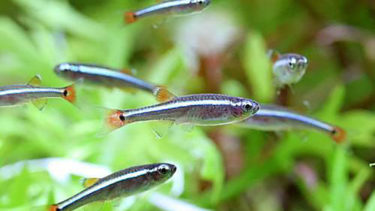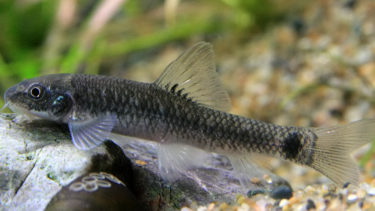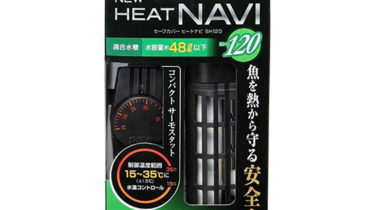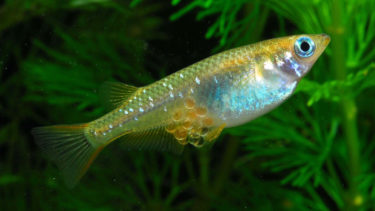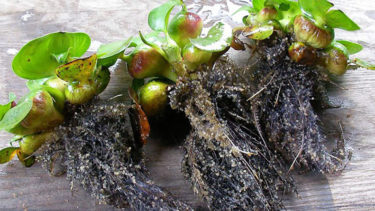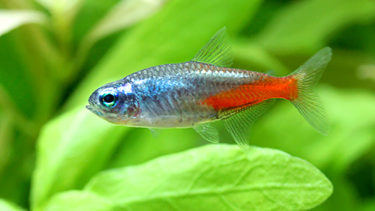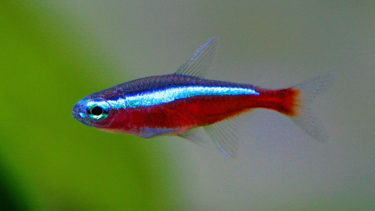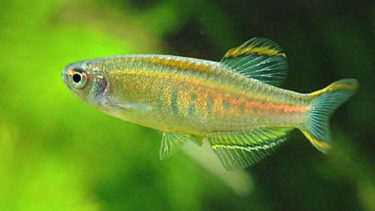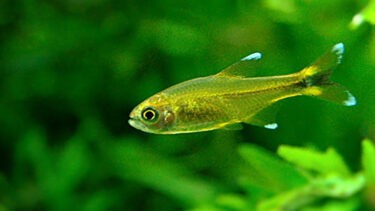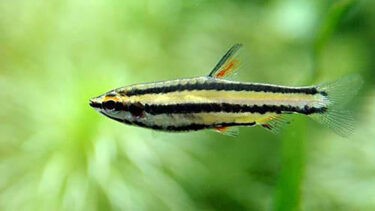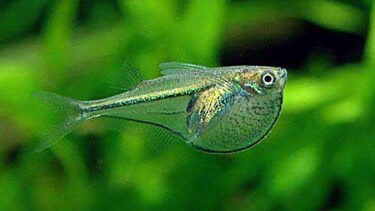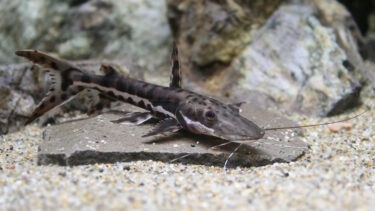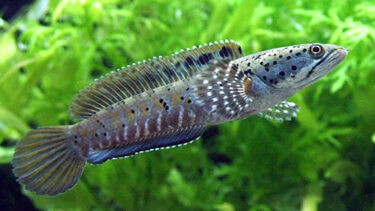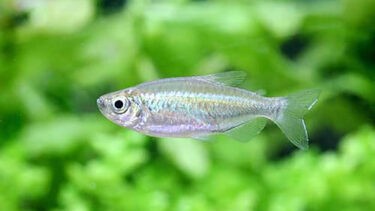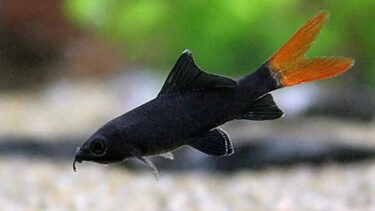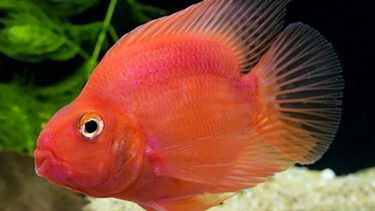The Orange Glitter Danio is a tropical fish belonging to the Danio genus of the carp family, Carpidae, native to the Irrawaddy River in northern Myanmar, with a beautiful yellow (orange) body color and pale spots on the sides of its body. In this article, I would like to explain in detail the characteristics of the Orange Glitter Danio and how to keep it.
What is Orange Glitter Danio?
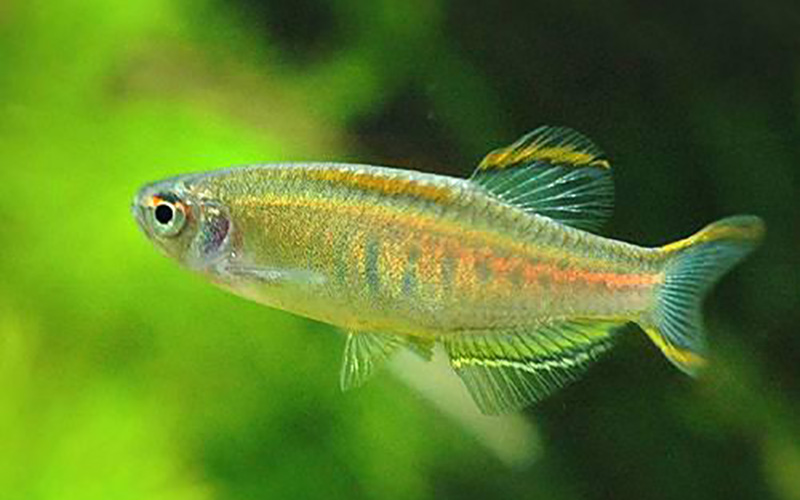
The Orange Glitter Danio is a tropical fish in the Danio genus of the Carp family. The origin of the Orange Glitter Danio is the Irrawaddy River in northern Myanmar, Southeast Asia.The Orange Glitter Danio is characterized by a colorful body color with beautiful yellow (orange) coloration. It also has pale spots on the sides of its body. The beautiful body color is further enhanced by exposure to light. Depending on the angle of view, the appearance of the spots changes depending on the reflection of the light, making this a variety that allows you to enjoy a different pattern each time you see it. Because of these characteristics, this variety is famous for its beautiful body color among the Danio genus.
The zebra danio is a tropical fish belonging to the Danio genus of the Carp family, Carpidae, native to the Koshi River in northern India. In this article, I would like to explain in detail the characteristics of the Zebra Danio and how to keep it. [...].
The redfin is a tropical fish of the carp family Tanichthys, which is native to Baiyunshan in Guangzhou, China. Its body color is mainly silver-gray with a dark blue line from the back of the eye to the base of the tail fin. In this article, we will explain in detail the characteristics of the redfin and how to keep it [...].
The gara rufa is a tropical fish of the family Carpidae, the genus Gara, native to Western Asia, including Turkey, Iran, and Iraq, and not very flashy with a blackish body color. Instead, it is known as a doctor fish because it removes dead skin cells from humans. In this issue of [...].
How to keep Orange Glitter Danio
Orange Glitter Danio will be an easy breed to keep. The lifespan of the Orange Glitter Danio is approximately 2 to 3 years. Its body size is about 4 cm. However, both lifespan and body size vary depending on the environment in which they are kept and the food they are fed. They prefer slightly acidic to slightly alkaline water with a pH range of 5.0 to 8.0. The Orange Glitter Danio is classified as a tropical fish and requires a heater in winter if kept in Japan.Due to their swimming habit (active swimming), they may jump out of the aquarium, so be sure to use glass plates or other measures to prevent this.
A heater is a device that maintains a constant water temperature. If you go to a specialty store that carries heaters, you will find a wide variety of types. Some people may be at a loss as to which one to choose. In this article, we would like to explain about such heaters [...]
Points to keep in mind when mixing swimmers

Regarding mixed swimming, first of all, the Orange Glitter Danio has a docile personality. Therefore, they can be mixed with other breeds. However, the Orange Glitter Danio is a very active breed, so be sure to check that they are eating well when mixing them with slower swimmers.Also, if the breed with which the Orange Glitter Danio is mixed is territorial or aggressive, the red fins may be attacked, resulting in injury or even illness due to stress. If the species you wish to mix with is aggressive, it is recommended that you take measures such as adding water plants or ornaments so that the red-finned fins can escape even if chased.
Points about spawning
Many people who keep Orange Glitter Danio want to breed them. Orange Glitter Danio are easy to keep, but breeding them is a little more difficult. However, it is possible to increase the number of Orange Glitter Danio in a stable manner if you know the procedure well.
The first is to keep individuals that are suitable for breeding.Orange Glitter Danio have a lifespan of about three years, so they are short-lived until they are ready to breed, roughly four to six months after birth. This means that if you want to breed them, it is important to choose relatively young individuals when purchasing them from specialty stores. It is also necessary to distinguish between male and female Orange Glitter Danio. Here, it is important to distinguish between males and females. The male Orange Glitter Danio is slimmer and the female has a fuller belly. However, it is difficult to tell them apart when they are small. As they grow older, the female's belly will gradually become fuller, and you will be able to tell male and female more clearly. If you want to know for sure whether you are looking for a male or a female, we recommend that you ask the staff at a specialty store.
The second thing to do is to prepare a breeding tank.As is common for those who have bred killifish, if the parents (adults) and fry (young) are kept in the same tank after successful spawning and hatching, they may compete for food or the adults may eat the fry, resulting in a decrease in the number of fry. To prevent this from happening, it is recommended that the parents and fry be kept in separate aquariums for easier management. However, unlike killifish, Orange Glitter Danio is a tropical fish, so a heater is recommended during non-summer months. This is also true for the fry, so if you are not sure whether or not to purchase a heater for the aquarium in which you will keep the fry, you may be able to find equipment at specialty stores that will allow you to borrow part of the aquarium in which you are keeping the parents to make space for the fry.
Many people who keep killifish want them to spawn. However, not many people know about spawning and what they need to do to prepare for it. This time, we would like to explain the method of spawning and the points to be noted [...].
If you have kept goldfish for a long time, you may want to try to breed them. However, if goldfish spawning is not done with care, there is a high possibility that the goldfish will weaken. In this article, I would like to explain in detail the method and precautions for spawning. The time of spawningThe time of spawning of goldfish is [...]
What to look for when keeping Orange Glitter Danio.
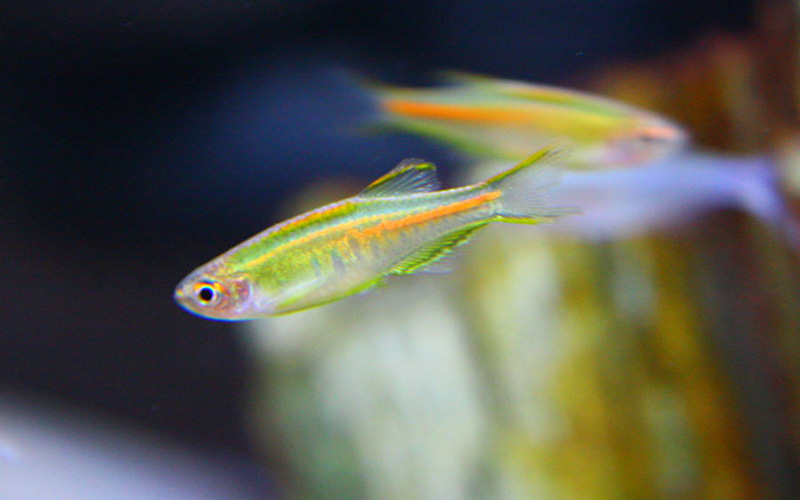
The Orange Glitter Danio is recommended for its ease of keeping and mixed swimming. However, in general, the Orange Glitter Danio is not as popular as the Neon Tetra or Guppy. This is due to the swimming ability of the Orange Glitter Danio, which is one of its characteristics. When you see Orange Glitter Danio in specialty stores, they are restless and always moving.This is the result of the evolution of the orange-glitter danios to prevent them from being caught by enemies. However, for those who keep them because they want a relaxing effect, they can become irritable if they are constantly on the move. This has spread through the Internet and word-of-mouth, and has created a bad image in many parts of the world. Therefore, it should be noted that the Orange Glitter Danio may not be suitable for those who want to appreciate tropical fish slowly or those who are not fond of varieties that move around too much. Also, because of its agile movements, it is common to have a hard time catching the Orange Glitter Danio during water changes, etc. If you don't mind, this is a highly recommended tropical fish. If you are interested, I recommend you to take a look at the Orange Glitter Danio at a specialty store.
The neon tetra is a tropical fish in the family Carassinae, and is a beautiful fish with a blue glow from its head to its tail fin. In this article, I would like to explain in detail the characteristics of the Neon Tetra and how to keep it. What is a Neon Tetra?
The cardinal tetra is a tropical fish of the family Carassinae of the order Carassinae that lives in the Negro and Amazon rivers in South America. It is a beautiful fish with a blue glow from its head to its tail fin. In this article, I would like to explain in detail the characteristics of the Cardinal Tetra and how to keep it. [...].



